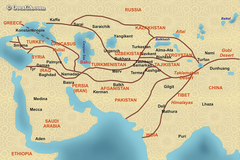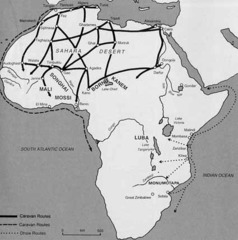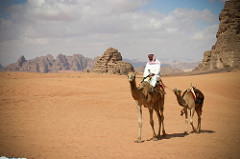A. Silk Road
The map to the right is which trade route?
a. indian ocean basin
b. Mediterranean sea
c. silk road
d. trans saharan caravan
D. Trans Saharan caravan
The map to the right is which trade route?
a. indian ocean basin
b. Mediterranean sea
c. silk road
d. trans saharan caravan
B. The Mongols patrolled trade routes and protected caravans in their empire, leading to a boom in trade along the Silk Road.
Which of the following is a correct analysis of the impact of the early Mongol Empire on trade?
A. The Mongols looted caravans to the point that the Silk Road no longer facilitated trade across Asia.
B. The Mongols patrolled trade routes and protected caravans in their empire, leading to a boom in trade along the Silk Road.
C. Merchants sought other routes, especially through Southeast Asia and the Indian Ocean, to avoid the Mongol tribesmen.
D. Merchants were forced to turn to other professions as the Mongols refused to allow other peoples to move through their empire.
what was the Silk Road, what was it named after ?
The most extensive of the land-based trade routes in the world during c. 600 BCE - c. 600 CE. It was named after its highly valued silk, which China could only make for centuries. The exchange of grains and fabrics across Eurasia due to this trading route. It changed farming techniques and allowed crops to grow in new regions. Merchants and missionaries from S. Asia introduced Buddhism along these trade routes which had lasting effects on E. and Southeast Asia. The Black Death was able to reach widely because of these trading routes as it crossed Afro-Eurasia along these routes. These routes ran roughly east to west.
What goods were traded on the trans-saharan routes?
Gold, Ivory, spices, iron,silver,wheat
What Was the impact of the silk road?
There was a development of civilizations and economics, the spread of culture and religion such as Confucianism, Christianity and Buddhism.
what was used as transportation on the Trans-Saharan routes?
Cattle, Horses, Light chariots and camels
What technologies enabled
long-distance overland and
maritime trade?
A.New technologies such as saddles or stirrups permitted the use of domesticated pack animals such as horses, oxen, or camels to transport goods across longer routes.
OR
B. Innovations in maritime technologies such as the lateen sail or dhow ships as well as advanced knowledge of the monsoon winds improved exchanges along maritime routes from East Africa to East Asian.
What was the relationship
between trade networks and
religions?
Religious and cultural traditions were transformed as they spread including Chinese culture, Christianity, Hinduism and Buddhism.
What goods were traded on the Indian Ocean?
Spices, pearls, and exotic animals.






